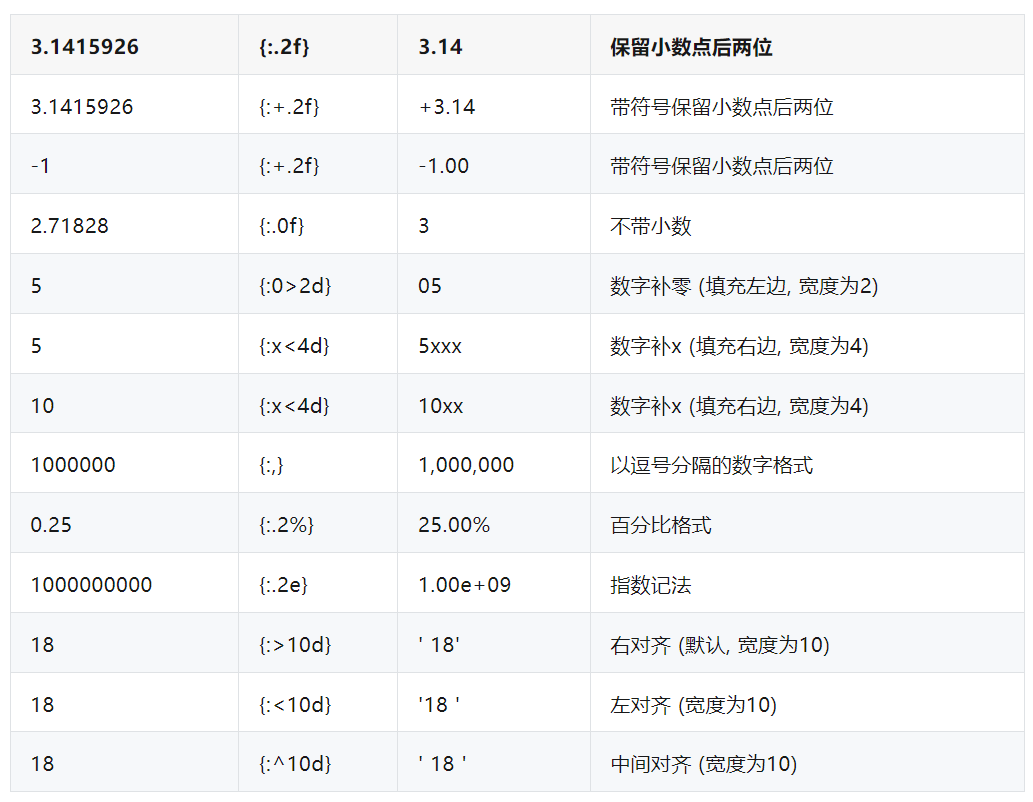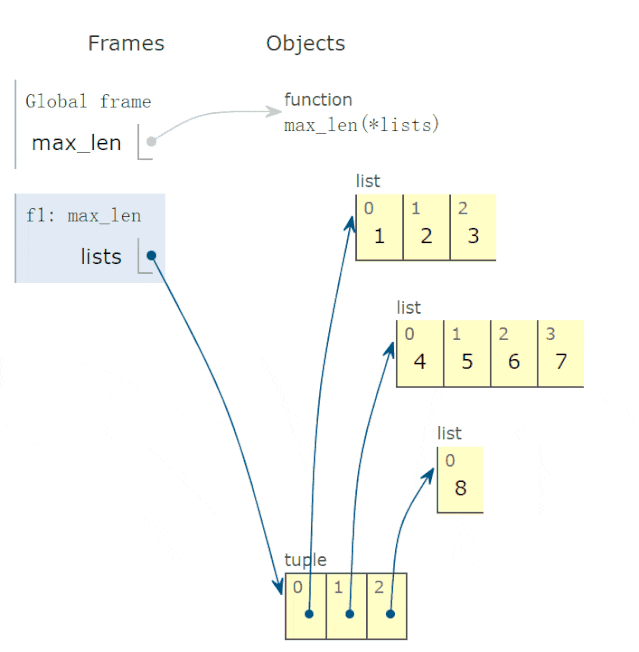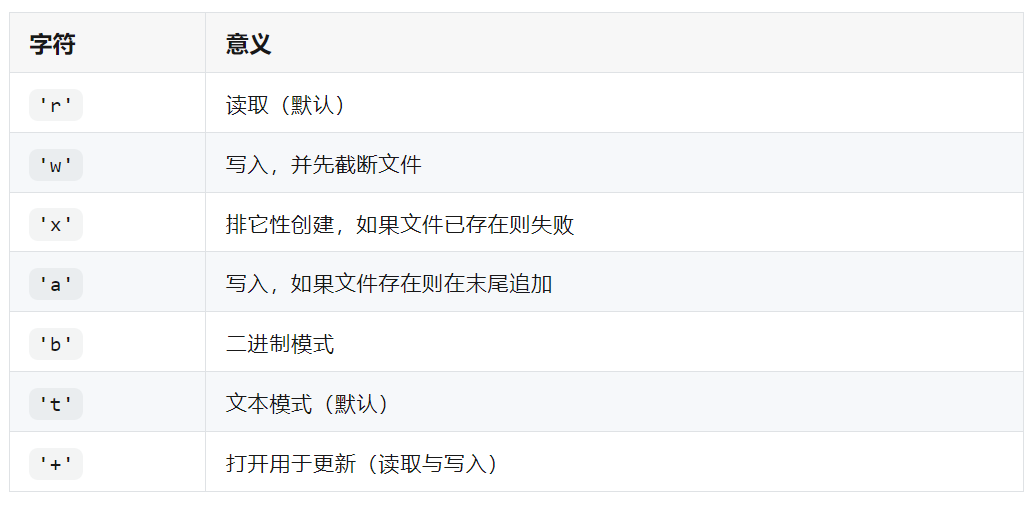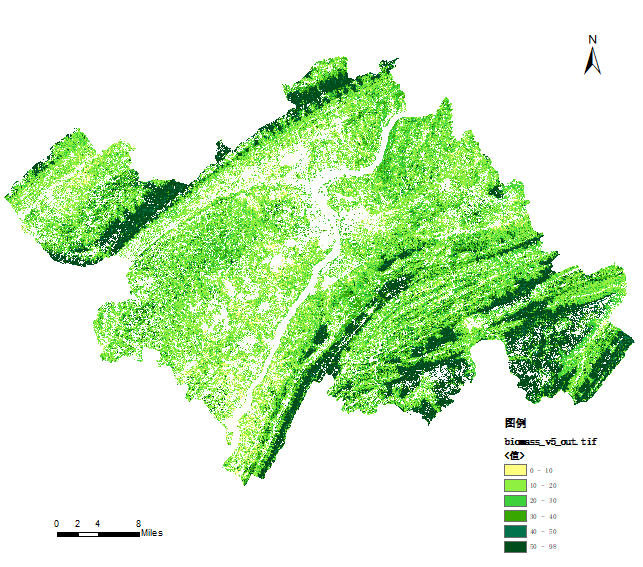
一、 数字
1 求绝对值
- 绝对值或复数的模
In [1]: abs(-6)``Out[1]: 6
2 进制转化
- 十进制转换为二进制:
In [2]: bin(10)``Out[2]: '0b1010'
- 十进制转换为八进制:
In [3]: oct(9)``Out[3]: '0o11'
- 十进制转换为十六进制:
In [4]: hex(15)``Out[4]: '0xf'
3 整数和ASCII互转
- 十进制整数对应的ASCII字符
In [1]: chr(65)``Out[1]: 'A'
- 查看某个ASCII字符对应的十进制数
In [1]: ord('A')``Out[1]: 65In [1]: ord('A')``Out[1]: 65
4 元素都为真检查
- 所有元素都为真,返回 True,否则为False
In [5]: all([1,0,3,6])``Out[5]: False``
In [6]: all([1,2,3])``Out[6]: True
5 元素至少一个为真检查
- 至少有一个元素为真返回True,否则False
In [7]: any([0,0,0,[]])``Out[7]: False``
In [8]: any([0,0,1])``Out[8]: True
6 判断是真是假
- 测试一个对象是True, 还是False.
In [9]: bool([0,0,0])``Out[9]: True`` ``
In [10]: bool([])``Out[10]: False`` ``
In [11]: bool([1,0,1])``Out[11]: True
7 创建复数
- 创建一个复数
In [1]: complex(1,2)``Out[1]: (1+2j)
8 取商和余数
- 分别取商和余数
In [1]: divmod(10,3)``Out[1]: (3, 1)
9 转为浮点类型
- 将一个整数或数值型字符串转换为浮点数
In [1]: float(3)``Out[1]: 3.0
- 如果不能转化为浮点数,则会报ValueError:
In [2]: float('a')``
# ValueError: could not convert string to float: 'a'
10 转为整型
- int(x, base =10) , x可能为字符串或数值,将x 转换为一个普通整数。如果参数是字符串,那么它可能包含符号和小数点。如果超出了普通整数的表示范围,一个长整数被返回。
In [1]: int('12',16)``Out[1]: 18
11 次幂
- base为底的exp次幂,如果mod给出,取余
In [1]: pow(3, 2, 4)``Out[1]: 1
12 四舍五入
- 四舍五入,ndigits代表小数点后保留几位:
In [11]: round(10.0222222, 3)``Out[11]: 10.022`` ``
In [12]: round(10.05,1)``Out[12]: 10.1
13 链式比较
i = 3``print(1 < i < 3)
# False``print(1 < i <= 3) # True
二、 字符串
14 字符串转字节
- 字符串转换为字节类型
In [12]: s = "apple"` ` ``
In [13]: bytes(s,encoding='utf-8')``Out[13]: b'apple'
15 任意对象转为字符串
In [14]: i = 100` ` ``
In [15]: str(i)``Out[15]: '100'`` ``
In [16]: str([])``Out[16]: '[]'`` ``
In [17]: str(tuple())``Out[17]: '()'
16 执行字符串表示的代码
- 将字符串编译成python能识别或可执行的代码,也可以将文字读成字符串再编译。
In [1]: s = "print('helloworld')"`
`In [2]: r = compile(s,"<string>", "exec")`
`In [3]: r``Out[3]: <code object <module> at 0x0000000005DE75D0, file "<string>", line 1>`
`In [4]: exec(r)``helloworld
17 计算表达式
- 将字符串str 当成有效的表达式来求值并返回计算结果取出字符串中内容
In [1]: s = "1 + 3 +5"` `...: eval(s)` `...:``Out[1]: 9
18 字符串格式化
- 格式化输出字符串,format(value, format_spec)实质上是调用了value的__format__(format_spec)方法。
In [104]: print("i am {0},age{1}".format("tom",18))``i am tom,age18

三、 函数
19 拿来就用的排序函数
- 排序:
In [1]: a = [1,4,2,3,1]`` ``
In [2]: sorted(a,reverse=True)``Out[2]: [4, 3, 2, 1, 1]`` ``
In [3]: a = [{'name':'xiaoming','age':18,'gender':'male'},{'name':'` `...: xiaohong','age':20,'gender':'female'}]``
In [4]: sorted(a,key=lambda x: x['age'],reverse=False)``Out[4]:``[{'name': 'xiaoming', 'age': 18, 'gender': 'male'},` `{'name': 'xiaohong', 'age': 20, 'gender': 'female'}]
20 求和函数
- 求和:
In [181]: a = [1,4,2,3,1]`` ``In [182]: sum(a)``Out[182]: 11`` ``In [185]: sum(a,10)
#求和的初始值为10``Out[185]: 21
21 nonlocal用于内嵌函数中
- 关键词nonlocal常用于函数嵌套中,声明变量i为非局部变量;如果不声明,i+=1表明i为函数wrapper内的局部变量,因为在i+=1引用(reference)时,i未被声明,所以会报unreferenced variable的错误。
def excepter(f):` `i = 0` `t1 = time.time()`
def wrapper():
try:``f()
except Exception as e:
nonlocal i` `i += 1`
print(f'{e.args[0]}: {i}') t2 = time.time()
if i == n:`
print(f'spending time:{round(t2-t1,2)}')
return wrapper
22 global 声明全局变量
- 先回答为什么要有global,一个变量被多个函数引用,想让全局变量被所有函数共享。有的伙伴可能会想这还不简单,这样写:
i = 5``def f():` `print(i)`` ``def g():` `print(i)` `pass`` ``f()``g()
- f和g两个函数都能共享变量i,程序没有报错,所以他们依然不明白为什么要用global. 但是,如果我想要有个函数对i递增,这样:
def h():` `i += 1`` ``h()
- 此时执行程序,bang, 出错了!抛出异常:UnboundLocalError,原来编译器在解释i+=1时会把i解析为函数h()内的局部变量,很显然在此函数内,编译器找不到对变量i的定义,所以会报错。
- global就是为解决此问题而被提出,在函数h内,显式地告诉编译器i为全局变量,然后编译器会在函数外面寻找i的定义,执行完i+=1后,i还为全局变量,值加1:
i = 0``def h():` `global i` `i += 1`` ``h()``print(i)
23 交换两元素
def swap(a, b):` `return b, a`` `` ``print(swap(1, 0)) # (0,1)
24 操作函数对象
- 创建函数对象的list,根据想要调用的index,方便统一调用。
In [31]: def f():` `...:
print('i\'m f')` `...:`` ``In [32]: def g():` `...:
print('i\'m g')` `...:`` ``In [33]: [f,g][1]()``i'm g
25 生成逆序序列
- 第三个参数为负时,表示从第一个参数开始递减,终止到第二个参数(不包括此边界)
list(range(10,-1,-1)) # [10, 9, 8, 7, 6, 5, 4, 3, 2, 1, 0]
26 函数的五类参数使用例子
- Python五类参数:位置参数,关键字参数,默认参数,可变位置或关键字参数的使用。
def f(a,*b,c=10,**d):` `print(f'a:{a},b:{b},c:{c},d:{d}')
- 默认参数c不能位于可变关键字参数d后. 调用f:
In [10]: f(1,2,5,width=10,height=20)``a:1,b:(2, 5),c:10,d:{'width': 10, 'height': 20}
- 可变位置参数b实参后被解析为元组(2,5);而c取得默认值10; d被解析为字典,再次调用f:
In [11]: f(a=1,c=12)``a:1,b:(),c:12,d:{}
- a=1传入时a就是关键字参数,b,d都未传值,c被传入12,而非默认值。
- 注意观察参数a, 既可以f(1),也可以f(a=1) 其可读性比第一种更好,建议使用f(a=1)。如果要强制使用f(a=1),需要在前面添加一个星号:
def f(*,a,**b):` `print(f'a:{a},b:{b}')
- 此时f(1)调用,将会报错:TypeError: f() takes 0 positional arguments but 1 was given
- 只能f(a=1)才能OK.
- 说明前面的*发挥作用,它变为只能传入关键字参数,那么如何查看这个参数的类型呢?借助python的inspect模块:
In [22]: for name,val in signature(f).parameters.items():` `...:
print(name,val.kind)` `...:``a KEYWORD_ONLY``b VAR_KEYWORD
- 可看到参数a的类型为KEYWORD_ONLY,也就是仅仅为关键字参数。但是,如果f定义为:
def f(a,*b):` `print(f'a:{a},b:{b}')
- 查看参数类型:
In [24]: for name,val in signature(f).parameters.items():` `...:
print(name,val.kind)` `...:``a POSITIONAL_OR_KEYWORD``b VAR_POSITIONAL
- 可以看到参数a既可以是位置参数也可是关键字参数。
27 使用slice对象
- 生成关于蛋糕的序列cake1:
In [1]: cake1 = list(range(5,0,-1))`` ``
In [2]: b = cake1[1:10:2]`` ``
In [3]: b``Out[3]: [4, 2]`` ``
In [4]: cake1``Out[4]: [5, 4, 3, 2, 1]
- 再生成一个序列:
In [5]: from random import randint` `...:
cake2 = [randint(1,100) for _ in range(100)]` `...:
# 同样以间隔为2切前10个元素,得到切片d` `...: d = cake2[1:10:2]``In [6]: d``Out[6]: [75, 33, 63, 93, 15]
- 你看,我们使用同一种切法,分别切开两个蛋糕cake1,cake2. 后来发现这种切法极为经典,又拿它去切更多的容器对象。
- 那么,为什么不把这种切法封装为一个对象呢?于是就有了slice对象。
- 定义slice对象极为简单,如把上面的切法定义成slice对象:
perfect_cake_slice_way = slice(1,10,2)``
#去切cake1``cake1_slice = cake1[perfect_cake_slice_way]``cake2_slice = cake2[perfect_cake_slice_way]`` ``
In [11]: cake1_slice``Out[11]: [4, 2]`` ``
In [12]: cake2_slice``Out[12]: [75, 33, 63, 93, 15]
- 与上面的结果一致。对于逆向序列切片,slice对象一样可行:
a = [1,3,5,7,9,0,3,5,7]``a_ = a[5:1:-1]`` ``
named_slice = slice(5,1,-1)``a_slice = a[named_slice]`` ``
In [14]: a_``Out[14]: [0, 9, 7, 5]`` ``
In [15]: a_slice``Out[15]: [0, 9, 7, 5]
- 频繁使用同一切片的操作可使用slice对象抽出来,复用的同时还能提高代码可读性。
28 lambda 函数的动画演示
- 有些读者反映,lambda函数不太会用,问我能不能解释一下。
- 比如,下面求这个 lambda函数:
def max_len(*lists):` `return max(*lists, key=lambda v: len(v))
- 有两点疑惑:
- 参数v的取值?
- lambda函数有返回值吗?如果有,返回值是多少?
- 调用上面函数,求出以下三个最长的列表:
r = max_len([1, 2, 3], [4, 5, 6, 7], [8])``print(f'更长的列表是{r}')
- 程序完整运行过程,动画演示如下:

####结论:
- 参数v的可能取值为*lists,也就是 tuple 的一个元素。
- lambda函数返回值,等于lambda v冒号后表达式的返回值。
四、 数据结构
29 转为字典
- 创建数据字典
In [1]: dict()``Out[1]: {}`` ``
In [2]: dict(a='a',b='b')``Out[2]: {'a': 'a', 'b': 'b'}`` ``
In [3]: dict(zip(['a','b'],[1,2]))``Out[3]: {'a': 1, 'b': 2}`` ``
In [4]: dict([('a',1),('b',2)])``Out[4]: {'a': 1, 'b': 2}
30 冻结集合
- 创建一个不可修改的集合。
In [1]: frozenset([1,1,3,2,3])``Out[1]: frozenset({1, 2, 3})
- 因为不可修改,所以没有像set那样的add和pop方法
31 转为集合类型
- 返回一个set对象,集合内不允许有重复元素:
In [159]: a = [1,4,2,3,1]`` ``In [160]: set(a)``Out[160]: {1, 2, 3, 4}
32 转为切片对象
- class slice(start, stop[, step]) 返回一个表示由 range(start, stop, step) 所指定索引集的 slice对象,它让代码可读性、可维护性变好。
In [1]: a = [1,4,2,3,1]`` ``
In [2]: my_slice_meaning = slice(0,5,2)`` ``
In [3]: a[my_slice_meaning]``Out[3]: [1, 2, 1]
33 转元组
- tuple() 将对象转为一个不可变的序列类型
In [16]: i_am_list = [1,3,5]``
In [17]: i_am_tuple = tuple(i_am_list)``
In [18]: i_am_tuple``Out[18]: (1, 3, 5)
五、 类和对象
34 是否可调用
- 检查对象是否可被调用
In [1]: callable(str)``Out[1]: True`` ``
In [2]: callable(int)``Out[2]: True``
In [18]: class Student():` `...:
def __init__(self,id,name):` `...:
self.id = id` `...:
self.name = name` `...:
def __repr__(self):` `...:
return 'id = '+self.id +', name = '+self.name` `...`` ``
In [19]: xiaoming = Student('001','xiaoming')`` ``
In [20]: callable(xiaoming)``Out[20]: False
- 如果能调用xiaoming(), 需要重写Student类的__call__方法:
In [1]: class Student():` `...:
def __init__(self,id,name):` `...:
self.id = id` `...:
self.name = name` `...:
def __repr__(self):` `...:
return 'id = '+self.id +', name = '+self.name` `...:
def __call__(self):` `...:
print('I can be called')` `...:
print(f'my name is {self.name}')` `...:`` ``
In [2]: t = Student('001','xiaoming')`` ``
In [3]: t()``I can be called``my name is xiaoming
35 ascii 展示对象
- 调用对象的 repr 方法,获得该方法的返回值,如下例子返回值为字符串
>>> class Student():`
>`def __init__(self,id,name):`
>`self.id = id`
>`self.name = name`
>`def __repr__(self):`
>`return 'id = '+self.id +', name = '+self.name
- 调用:
>>> xiaoming = Student(id='1',name='xiaoming')``
>>>> xiaoming``id = 1, name = xiaoming``
>>>> ascii(xiaoming)``'id = 1, name = xiaoming'
36 类方法
- classmethod 装饰器对应的函数不需要实例化,不需要 self 参数,但第一个参数需要是表示自身类的 cls 参数,可以来调用类的属性,类的方法,实例化对象等。
In [1]: class Student():` `...:
def __init__(self,id,name):` `...:
self.id = id` `...:
self.name = name` `...:
def __repr__(self):` `...:
return 'id = '+self.id +', name = '+self.name` `...:
@classmethod` `...:
def f(cls):` `...:
print(cls)
37 动态删除属性
- 删除对象的属性
In [1]: delattr(xiaoming,'id')`` ``
In [2]: hasattr(xiaoming,'id')``Out[2]: False
38 一键查看对象所有方法
- 不带参数时返回当前范围内的变量、方法和定义的类型列表;带参数时返回参数的属性,方法列表。
In [96]: dir(xiaoming)``Out[96]:``
['__class__',` `'__delattr__',` `'__dict__',` `'__dir__',` `'__doc__',` `'__eq__',` `'__format__',` `'__ge__',` `'__getattribute__',` `'__gt__',` `'__hash__',` `'__init__',` `'__init_subclass__',` `'__le__',` `'__lt__',` `'__module__',` `'__ne__',` `'__new__',` `'__reduce__',` `'__reduce_ex__',` `'__repr__',` `'__setattr__',` `'__sizeof__',` `'__str__',` `'__subclasshook__',` `'__weakref__',` ` 'name']
39 动态获取对象属性
- 获取对象的属性
In [1]: class Student():` `...:
def __init__(self,id,name):` `...:
self.id = id` `...:
self.name = name` `...:
def __repr__(self):` `...:
return 'id = '+self.id +', name = '+self.name`` ``
In [2]: xiaoming = Student(id='001',name='xiaoming')``
In [3]: getattr(xiaoming,'name')
# 获取xiaoming这个实例的name属性值``Out[3]: 'xiaoming'
40 对象是否有这个属性
In [1]: class Student():` `...:
def __init__(self,id,name):` `...:
self.id = id` `...:
self.name = name` `...:
def __repr__(self):` `...:
return 'id = '+self.id +', name = '+self.name`` ``
In [2]: xiaoming = Student(id='001',name='xiaoming')``
In [3]: hasattr(xiaoming,'name')``Out[3]: True`` ``
In [4]: hasattr(xiaoming,'address')``Out[4]: False
41 对象门牌号
- 返回对象的内存地址
In [1]: id(xiaoming)``Out[1]: 98234208
42 isinstance
- 判断object是否为类classinfo的实例,是返回true
In [1]: class Student():` `...:
def __init__(self,id,name):` `...:
self.id = id` `...:
self.name = name` `...:
def __repr__(self):` `...:
return 'id = '+self.id +', name = '+self.name`` ``
In [2]: xiaoming = Student(id='001',name='xiaoming')`` ``
In [3]: isinstance(xiaoming,Student)``Out[3]: True
43 父子关系鉴定
In [1]: class undergraduate(Student):` `...:
def studyClass(self):` `...: pass` `...:
def attendActivity(self):` `...: pass`` ``
In [2]: issubclass(undergraduate,Student)``Out[2]: True`` ``
In [3]: issubclass(object,Student)``Out[3]: False`` ``
In [4]: issubclass(Student,object)``Out[4]: True
- 如果class是classinfo元组中某个元素的子类,也会返回True
In [1]: issubclass(int,(int,float))``Out[1]: True
44 所有对象之根
- object 是所有类的基类
In [1]: o = object()`` ``
In [2]: type(o)``Out[2]: object
45 创建属性的两种方式
- 返回 property 属性,典型的用法:
class C:` `def __init__(self):`
`self._x = None`` `
`def getx(self):`
`return self._x`` `
`def setx(self, value):`
`self._x = value`` `
`def delx(self):`
`del self._x` `
# 使用property类创建 property 属性` `x = property(getx, setx, delx, "I'm the 'x' property.")
- 使用python装饰器,实现与上完全一样的效果代码:
class C:`
`def __init__(self):`
`self._x = None`` `
`@property`
`def x(self):`
`return self._x`` `
`@x.setter`
`def x(self, value):`
`self._x = value`` `
`@x.deleter`
`def x(self):`
`del self._x
46 查看对象类型
- class type(name, bases, dict)
- 传入一个参数时,返回 object 的类型:
In [1]: class Student():` `...:
def __init__(self,id,name):` `...:
self.id = id` `...:
self.name = name` `...:
def __repr__(self):` `...:
return 'id = '+self.id +', name = '+self.name` `...:`` ``
In [2]: xiaoming = Student(id='001',name='xiaoming')``
In [3]: type(xiaoming)``Out[3]: __main__.Student`` ``
In [4]: type(tuple())``Out[4]: tuple
47 元类
- xiaoming, xiaohong, xiaozhang 都是学生,这类群体叫做 Student.
- Python 定义类的常见方法,使用关键字 class
In [36]: class Student(object):` `...: pass
- xiaoming, xiaohong, xiaozhang 是类的实例,则:
xiaoming = Student()``xiaohong = Student()``xiaozhang = Student()
- 创建后,xiaoming 的 class 属性,返回的便是 Student类
In [38]: xiaoming.__class__``Out[38]: __main__.Student
- 问题在于,Student 类有 _class_属性,如果有,返回的又是什么?
In [39]: xiaoming.__class__.__class__``Out[39]: type
- 哇,程序没报错,返回 type 那么,我们不妨猜测:Student 类,类型就是 type,换句话说,Student类就是一个对象,它的类型就是 type,所以,Python 中一切皆对象,类也是对象
- Python 中,将描述 Student 类的类被称为:元类。
- 按照此逻辑延伸,描述元类的类被称为:元元类,开玩笑了~ 描述元类的类也被称为元类。
- 聪明的朋友会问了,既然 Student 类可创建实例,那么 type 类可创建实例吗?如果能,它创建的实例就叫:类 了。你们真聪明!
- 说对了,type 类一定能创建实例,比如 Student 类了。
In [40]: Student = type('Student',(),{})`` ``In [41]: Student``Out[41]: __main__.Student
- 它与使用 class 关键字创建的 Student 类一模一样。
Python 的类,因为又是对象,所以和 xiaoming,xiaohong 对象操作相似。支持:
In [43]: StudentMirror = Student
# 类直接赋值 # 类直接赋值``In [44]: Student.class_property = 'class_property'
# 添加类属性``In [46]: hasattr(Student, 'class_property')``Out[46]: True
- 元类,确实使用不是那么多,也许先了解这些,就能应付一些场合。就连 Python 界的领袖 Tim Peters 都说:“元类就是深度的魔法,99%的用户应该根本不必为此操心。
六、工具
48 枚举对象
- 返回一个可以枚举的对象,该对象的next()方法将返回一个元组。
In [1]: s = ["a","b","c"]` `...: for i ,v in enumerate(s,1):` `...:
print(i,v)` `...:``1 a``2 b``3 c
49 查看变量所占字节数
In [1]: import sys`` ``In [2]: a = {'a':1,'b':2.0}`` ``
In [3]: sys.getsizeof(a) # 占用240个字节``Out[3]: 240
50 过滤器
- 在函数中设定过滤条件,迭代元素,保留返回值为True的元素:
In [1]: fil = filter(lambda x: x>10,[1,11,2,45,7,6,13])`` ``
In [2]: list(fil)``Out[2]: [11, 45, 13]
51 返回对象的哈希值
- 返回对象的哈希值,值得注意的是自定义的实例都是可哈希的,list, dict, set等可变对象都是不可哈希的(unhashable)
In [1]: hash(xiaoming)``Out[1]: 6139638`` ``
In [2]: hash([1,2,3])`` ``
# TypeError: unhashable type: 'list'
52 一键帮助
- 返回对象的帮助文档
In [1]: help(xiaoming)``Help on Student in module __main__ object:`` ``
class Student(builtins.object)` `|
Methods defined here:` `|` `| __init__(self, id, name)` `|` `| __repr__(self)` `|` `|
Data descriptors defined here:` `|` `| __dict__` `|
dictionary for instance variables (if defined)` `|` `| __weakref__` `|
list of weak references to the object (if defined)
53 获取用户输入
- 获取用户输入内容
In [1]: input()``aa``Out[1]: 'aa'
54 创建迭代器类型
- 使用iter(obj, sentinel), 返回一个可迭代对象, sentinel可省略(一旦迭代到此元素,立即终止)
In [1]: lst = [1,3,5]`` ``
In [2]: for i in iter(lst):` `...:
print(i)` `...:``1``3``5``In [1]:
class TestIter(object):` `...:
def __init__(self):` `...:
self.l=[1,3,2,3,4,5]` `...:
self.i=iter(self.l)` `...:
def __call__(self):
#定义了__call__方法的类的实例是可调用的` `...:
item = next(self.i)` `...:
print ("__call__ is called,fowhich would return",item)` `...:
return item` `...:
def __iter__(self): #支持迭代协议(即定义有__iter__()函数)` `...:
print ("__iter__ is called!!")` `...:
return iter(self.l)``In [2]: t = TestIter()``In [3]: t()
# 因为实现了__call__,所以t实例能被调用``__call__ is called,which would return 1``Out[3]: 1`` ``
In [4]: for e in TestIter():
# 因为实现了__iter__方法,所以t能被迭代` `...:
print(e)`
`...:``__iter__ is called!!``1``3``2``3``4``5
55 打开文件
- 返回文件对象
In [1]: fo = open('D:/a.txt',mode='r', encoding='utf-8')`` ``
In [2]: fo.read()``Out[2]: '\ufefflife is not so long,\nI use Python to play.'
mode取值表:

56 创建range序列
- range(stop)
- range(start, stop[,step])
- 生成一个不可变序列:
In [1]: range(11)``Out[1]: range(0, 11)`` ``
In [2]: range(0,11,1)``Out[2]: range(0, 11)
57 反向迭代器
In [1]: rev = reversed([1,4,2,3,1])`` ``In [2]:
for i in rev:` `...:
print(i)` `...:``1``3``2``4``1
58 聚合迭代器
- 创建一个聚合了来自每个可迭代对象中的元素的迭代器:
In [1]: x = [3,2,1]``In [2]: y = [4,5,6]``
In [3]: list(zip(y,x))``
Out[3]: [(4, 3), (5, 2), (6, 1)]`` ``
In [4]: a = range(5)``
In [5]: b = list('abcde')``
In [6]: b``Out[6]: ['a', 'b', 'c', 'd', 'e']``
In [7]: [str(y) + str(x) for x,y in zip(a,b)]``
Out[7]: ['a0', 'b1', 'c2', 'd3', 'e4']
59 链式操作
from operator import (add, sub)`` `` ``
def add_or_sub(a, b, oper):` `
return (add if oper == '+' else sub)(a, b)`` `` ``
add_or_sub(1, 2, '-') # -1
60 对象序列化
- 对象序列化,是指将内存中的对象转化为可存储或传输的过程。很多场景,直接一个类对象,传输不方便。
- 但是,当对象序列化后,就会更加方便,因为约定俗成的,接口间的调用或者发起的 web 请求,一般使用 json 串传输。
- 实际使用中,一般对类对象序列化。先创建一个 Student 类型,并创建两个实例。
class Student():``
def __init__(self,**args):``
self.ids = args['ids']``
self.name = args['name']``
self.address = args['address']``xiaoming = Student(ids = 1,name = 'xiaoming',address = '北京')``xiaohong = Student(ids = 2,name = 'xiaohong',address = '南京')
- 导入 json 模块,调用 dump 方法,就会将列表对象 [xiaoming,xiaohong],序列化到文件 json.txt 中。
import json`` ``
with open('json.txt', 'w') as f:``
json.dump([xiaoming,xiaohong], f, default=lambda obj: obj.__dict__, ensure_ascii=False, indent=2, sort_keys=True)
- 生成的文件内容,如下:
[``{``"address":"北京",``"ids":1,``"name":"xiaoming"``},``{``"address":"南京",``"ids":2,``"name":"xiaohong"``}``]
总结
- 最后希望你编程学习上不急不躁,按照计划有条不紊推进,把任何一件事做到极致,都是不容易的,加油,努力!相信自己!
文末福利
- 最后这里免费分享给大家一份Python全套学习资料,希望能帮到那些不满现状,想提升自己却又没有方向的朋友,也可以和我一起来学习交流呀。
包含编程资料、学习路线图、源代码、软件安装包等!【[点击这里]】领取!
- ① Python所有方向的学习路线图,清楚各个方向要学什么东西
- ② 100多节Python课程视频,涵盖必备基础、爬虫和数据分析
- ③ 100多个Python实战案例,学习不再是只会理论
- ④ 华为出品独家Python漫画教程,手机也能学习
可以扫描下方二维码领取【保证100%免费】

![[ICS] 物理安全](https://img-blog.csdnimg.cn/img_convert/345ed33f47a2af29433820df448b9795.jpeg)


















